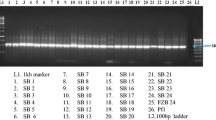Abstract
Field trial were conducted following split plot design in the year 2008–2009 and 2009–2010 under All India Co-ordinated Potato Research Project, Orissa University of Agriculture &Technology, Bhubaneswar with chemical soil amendments in main plots followed by individual and combine treatment of chemical and bio-agent treatments in the sub plots to study synergistic effect of Bacillus subtilis and boric acid on management of bacterial wilt of tomato caused by Ralstonia solanacearum (Smith) Yabuuchi. Combined potato seed treatment with B. subtilis BS-5 (6 × 106 CFU /ml) and 3% boric acid coupled with soil application of bleaching powder showed lower wilt incidence (9.55%) and enhanced yield (17.31 t/h) over control after 75 days of sowing under field conditions which is economical and also eco-friendly. With single application of boric acid (3%) or B. subtilis BS-5 (6 × 106 CFU /ml), wilt incidence were significantly higher 11.82 and 17.06% and yielded less healthy tubers 15.49 and 13.65 t/h, respectively. Though, the tubers treated with antibiotic streptocycline (150 ppm) followed by application of the same antibiotic at 10 days interval for four times after planting resulted in minimum wilting (3.83%) of plant and maximum of tuber yield (18.21 t/h) however it is more expensive and perilous.
Similar content being viewed by others
References
Arora RK, Sharma J, Garg ID, Singh RK, Somani AK (2006) Boric acid for control of tuber borne diseases. Technologies in Aid of Healthy Seed Production. Part 1I, Technical Central Potato Research Institute, Shimla Bulletin No. 35, 1–4
Czajkowski R, Perombelon MCM, van Veen JA, van der Wolf JM (2011) Control of black leg and tuber soft rot of potato caused by Pectobacterium and Dickeya species: a review. Plant Pathol. https://doi.org/10.1111/j.1365-3059.2011.02470.x
Ghosh PP, Mandal NC (2009) Some disease management practices for bacterial wilt of potato. J Plant Protect Sci 1(1):51–54
Gomez KA, Gomez AA (1984) Statistical procedures for agricultural research, 2 edn. Wiley, New York, p 680
Pandey SK (2007) CPRI in the service of the nation. In: Souvenir: potato production and utilization in India, pp 19–23
Rahman MM, Khan AA, Mian IH, AkandaA M, Alam MZ (2017) Effect of some chemicals on incidence of potato soft rot disease in Bangladesh, Bangladesh. J Sci Ind Res 52(2):135–140
Ramesh R, Phadke GS (2012) Rhizosphere and endophytic bacteria for the suppression of eggplant wilt caused by Ralstonia solanacearum. Crop Protection 37:35–41
Ranjan RK, Singh D, Sharma P, Shridhar (2015) Characterization and genetic diversity of Ralstonia solanacearum causing brown rot disease of potato. Indian Phytopath 68 (4):1–7
Sharma JP, Kumar S (2000) Management of Ralstonia wilt through soil disinfectant, mulch, lime and cakes in tomato (Lycopersicon esculentum). Indian J Agric Sci 70(1):17–19
Sharma JP, Kumar S (2009) Management of Ralstonia wilt of tomato through microbes, plant extract and combination of cake and chemicals. Indian Phytopath. 62(4):417–423
Sharma JP, Kumar SandKumar Sand Singh D (2016) Integrated management of bacterial wilt of tomato caused by Ralstonia solanacearum. Indian J Agric Sci 86(7):956–960
Singh D, Yadav DK, Sinha S, Singh H (2012a) Effect of safe chemicals and bleaching powder on bacterial wilt incidence in tomato caused by Ralstonia solanacearum race 1 bv. 3. Ann Plant Protect Sci 20(2):426–429
Singh D, Yadav DK, Sinha S, Upadhyay BK (2012b) Utilization of plant growth promoting Bacillus subtilis isolates for the management of bacterial wilt incidence in tomato caused by Ralstonia solanacearum race 1 biovar3. Indian Phytopath 65(1):18–24
Sunaina V, Pandy SK, Singh BP (2006) Bio-B5, an eco-friendly biopesticide-cum-biofertilizer for management of soil and tuber borne diseases of potato and other crops. Central Potato Research Institute Campus, Modipuram, Meerut, Extension. Bull, p 10
Verma R, Dutta A, Choudhary AK, Maurya S (2014) Control of Ralstonia solanacearum infection in tomato, brinjal and capsicum by antibiotic sensitivity test. J Adv Lab Res Biol 5(3):1–3
Yabuuchi E, Kosako Y, Yano I, Hotta H, Nishiuchi Y (1995) Transfer of two Burkholderia and an Alcaligenes species to Ralstonia genus nov.: proposal of Ralstonia pickettii (Ralston, Palleroni and Douderoff 1973) comb. nov., Ralstonia solanacearum (Smith 1896) comb. nov. and Ralstonia eutropha (Davis 1969) comb. nov. Microbiol Immunol 39:897–904
Author information
Authors and Affiliations
Corresponding author
Rights and permissions
About this article
Cite this article
Biswal, G., Singh, D. & Dhal, N.K. Synergistic effect of Bacillus subtilis and boric acid on management of bacterial wilt disease of potato caused by Ralstonia solanacearum in coastal plains of Odisha under field conditions. Indian Phytopathology 71, 431–434 (2018). https://doi.org/10.1007/s42360-018-0053-8
Received:
Revised:
Accepted:
Published:
Issue Date:
DOI: https://doi.org/10.1007/s42360-018-0053-8



